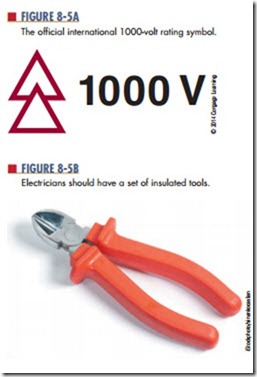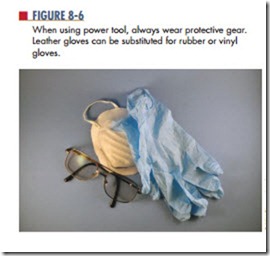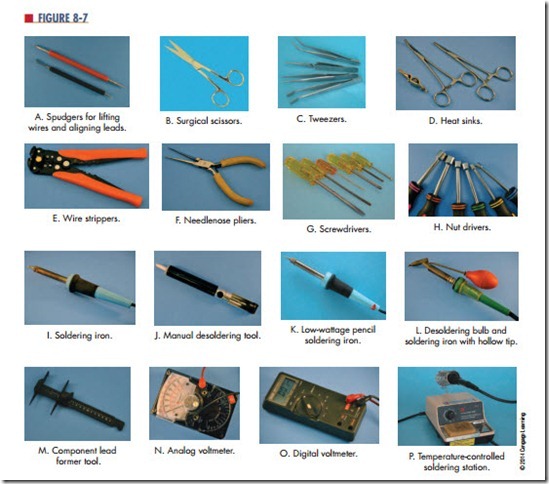using Hand and Power Tools
Hand tools are necessary for building electronics circuits. In the electronics workshop, hand tools are of great importance in what they are, what they will be used for, and how to use them. Most of the tools in the electronics workshop can be divided into groups by their use. Each tool has a special purpose and it is important for the electronics technician to know its purpose. Every prospective electronics technician should also learn how to care for the tools they use so each tool can function at its full potential.
Hand tools should always be kept clean, in good working condition, and free of rust. Using or storing the tools in a damp environment creates rust. The formation of rust can be prevented or kept to a minimum by occasionally spraying tools with an oil product or wiping tools with an oily rag. When rust does form, it can be removed easily with fine steel wool or a fine abrasive.
Technicians should also lubricate the moving parts of various tools to keep them working freely. Before using any tool, check to be sure it is in good condition. Never use a tool that is not in good condition.
Using the correct tool for the job is the first step in safe hand tool use. Tools are designed for specific needs. That’s why screwdrivers are made with various lengths and tip styles and pliers with different head shapes. The longer the screwdriver is, the more torque it can provide. To avoid personal injury and tool dam- age, select the proper tool to do the job well and safely.
Many jobs require the use of insulated tools to protect the user in the event a circuit is live. While you should always try to work on circuits that are not live,
there are times when a circuit cannot be shut down. All professionals need to have some insulated tools in their collection. Insulated hand tools must be clearly marked with the official, international 1000-volt rating symbol (Figure 8-5). These tools are designed to reduce the chance of injury if the tool should make contact with an energized source.
Inspect insulated tools frequently, watching for any wear or cracking of the insulation. Keep tools clean, dry, and free of surface contaminants, which can com- promise their insulating properties. If cutting, wear, or a burn has breached the dielectric insulation, the tool should not be used to ensure safety.
Power tools are classified as commercial or consumer, with commercial power tools used in business and industry, and consumer power tools used in a household. Power tools are useful in the following tasks: drilling, cutting, fastening, grind- ing, heating, painting, polishing, routing, sanding, shaping, and more. Power tools are also classified as either portable or stationary. Portable power tools are handheld and offer mobility. Stationary power tools cannot be moved but offer accuracy and speed. Stationary power tools are available for both metalworking and woodworking. Drill presses and band saws are used for both woodworking and metalworking.
Always protect your eyes, lungs and extremities when using power tools. Wear the protective gear shown in Figure 8-6. The Occupational Safety and Health Ad- ministration, OSHA, requires that any workers exposed to hazards of falling, flying, splashing objects or any- thing that can be inhaled, must use personal protective gear when in the work space. It doesn’t take much for an object in the eye to become a major irritation. It is better to cut a glove than skin. When working around fumes, wear the appropriate mask. Never wear long hair, loose clothing, ties or jewelry around power tools as they can get caught in the actions of the power tools.
Any power tool, such as a drill, saw, or impact wrench, generates torque when it is turned on. Torque
When using power tool, always wear protective gear. leather gloves can be substituted for rubber or vinyl gloves.
is the tendency of a power tool to rotate around its axis. Before using a power tool, determine how the torque influences the device as it is moved around, before ap- plying it to the task it was designed to do. Make sure to apply a good grip on the tool and balance yourself before using it as intended. When you are finished with the tool, disconnect it and store it properly.
If you are using any power tools that could throw off sparks, make sure that the workshop is vented for flammable gases. Keep the work area clean and dry to prevent accidental slipping with the tool.
Electric power tools present a hazard in that electricity always wants to make a path to ground. Power tools should always have a grounded three- wire cord. Never plug a three-prong cord into a two-prong receptacle, which removes the ground protection. All cords and extensions should be in original condition, with no cracks or frayed ends where they enter the plug or tool. If there is any sign of wear on the cord, discard it or repair the tool or extension cord.
Regulations require that all power tools be fitted with proper guards and safety switches. Guards protect the operator of power tools from exposed moving parts. Safety switches are used to prevent a tool from accidentally turning on and may require a minimum of two actions to turn a power tool on. Be- fore using any power tool, make sure the guards are in place and the switches are working properly.
Power tools are extremely dangerous when used improperly. Never use a power tool for anything other than its intended use.
Questions
1. Why must hand tools be kept in good working condition?
2. What groups can the hand tools in Figure 8-7 be divided into?
3. Why are screwdrivers made in different lengths?
4. Who specifies that technicians exposed to hazards in the workshop must wear protective gear?
5. How are power tools classified?


